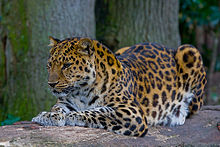Amur leopard
The Amur leopard (Panthera pardus orientalis) is a leopard subspecies. It is sometimes called the far eastern leopard.[2]
| Amur leopard | |
|---|---|

| |
| Scientific classification | |
| Kingdom: | |
| Phylum: | |
| Class: | |
| Order: | |
| Family: | |
| Genus: | |
| Species: | |
| Trinomial name | |
| Panthera pardus orientalis | |

| |
| Area of distribution | |
| Synonyms | |
|
Panthera pardus amurensis | |
The leopard lives in the Primorye region of southeastern Russia and in the Jilin Province of northeast China. It is critically endangered (IUCN). Only 14–20 adults and 5–6 cubs were counted in 2007. Only 19–26 Amur leopards live in the wild.[1]
The Amur leopard's range has decreased considerably in the previous century. This species is still at high risk of extinction, and conservation efforts are ongoing. [3]The Amur leopards are endangered because they have been hunted for their fur. Also because their food sources are running out due to them being hunted for their fur. Amur leopards can be recognized from the patterns in their fur. They weigh about 70 to 105 pounds (32 to 48 kg). They live in temperate, broadleaf and mixed forests. The Amur Leopard almost extinct by human hunting. It's called human hunting since the humans tear down the forest so no tree and bushes so the leopard cannot hide. At that time, they hunt them and sell to get money.
The number of Amur cats is decreasing due to the human activity, invasion of domestic cats, and infectious disease. Because these cats play a huge role and the ecosystem cannot afford to lose such species, researchers found a way to regenerate the endangered animal. This can be done from culture cell with somatic cloning technique.
They breed in spring and early summer. Most of them are in captive breeding programs. They give birth to one to four cubs. Inbreeding is common in the wild. Their diet consists of roe deer, sika deer, badgers and hares.
Among the Amur leopards, are Amur tigers, who are sympatric to Amur leopards. However, their activity patterns reveal low spatial overlap which allows these similar predators to coexist.[4]
References
change- ↑ 1.0 1.1 Jackson P. & Nowell K. (2008). "Panthera pardus ssp. orientalis". IUCN Red List of Threatened Species. Version 2012.2. International Union for Conservation of Nature.
- ↑ Uphyrkina, O.; Miquelle, D.; Quigley, H.; Driscoll, C.; O'Brien, S. J. (2002). "Conservation Genetics of the Far Eastern Leopard (Panthera pardus orientalis)". Journal of Heredity. 93 (5): 303–311. doi:10.1093/jhered/93.5.303. PMID 12547918.
- ↑ Yang, Li; Huang, Mujiao; Zhang, Rui; Jiang, Lv; Ren, Yueheng; Jiang, Zhe; Zhang, Wei; Luan, Xiaofeng (2016-05-25). "Reconstructing the historical distribution of the Amur Leopard (Panthera pardus orientalis) in Northeast China based on historical records". ZooKeys (592): 143–153. doi:10.3897/zookeys.592.6912. ISSN 1313-2970. PMC 4926640. PMID 27408548.
- ↑ Yang, Haitao; Zhao, Xiaodan; Han, Boyu; Wang, Tianming; Mou, Pu; Ge, Jianping; Feng, Limin (2018-03-22). "Spatiotemporal patterns of Amur leopards in northeast China: Influence of tigers, prey, and humans". Mammalian Biology 92 (2018): 120-128.
